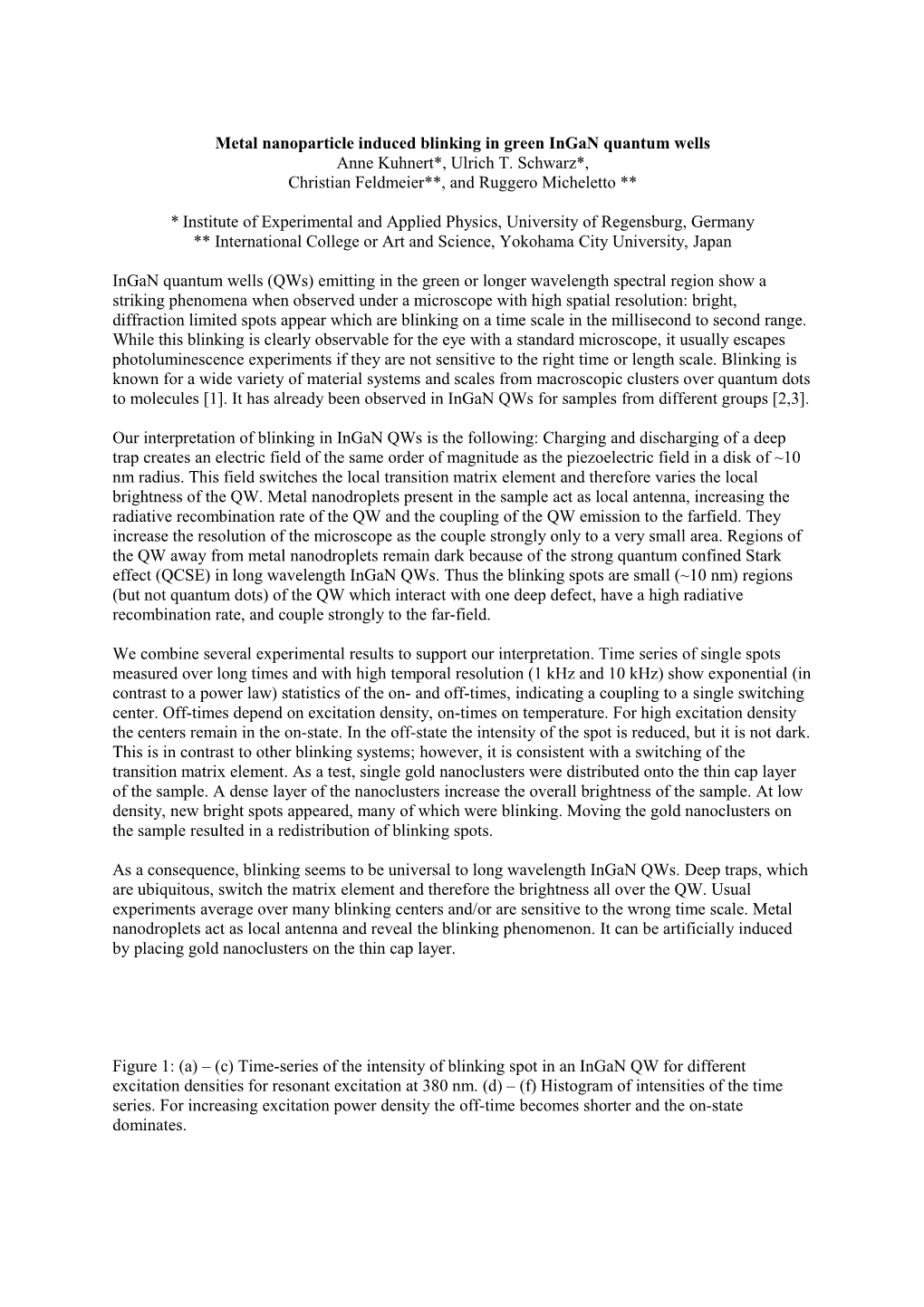Metal nanoparticle induced blinking in green InGaN quantum wells
Anne Kuhnert*, Ulrich T. Schwarz*,
Christian Feldmeier**, and Ruggero Micheletto **
* Institute of Experimental and Applied Physics, University of Regensburg, Germany
** International College or Art and Science, Yokohama City University, Japan
InGaN quantum wells (QWs) emitting in the green or longer wavelength spectral region show a striking phenomena when observed under a microscope with high spatial resolution: bright, diffraction limited spots appear which are blinking on a time scale in the millisecond to second range. While this blinking is clearly observable for the eye with a standard microscope, it usually escapes photoluminescence experiments if they are not sensitive to the right time or length scale. Blinking is known for a wide variety of material systems and scales from macroscopic clusters over quantum dots to molecules [1]. It has already been observed in InGaN QWs for samples from different groups [2,3].
Our interpretation of blinking in InGaN QWs is the following: Charging and discharging of a deep trap creates an electric field of the same order of magnitude as the piezoelectric field in a disk of ~10 nm radius. This field switches the local transition matrix element and therefore varies the local brightness of the QW. Metal nanodroplets present in the sample act as local antenna, increasing the radiative recombination rate of the QW and the coupling of the QW emission to the farfield. They increase the resolution of the microscope as the couple strongly only to a very small area. Regions of the QW away from metal nanodroplets remain dark because of the strong quantum confined Stark effect (QCSE) in long wavelength InGaN QWs. Thus the blinking spots are small (~10 nm) regions (but not quantum dots) of the QW which interact with one deep defect, have a high radiative recombination rate, and couple strongly to the far-field.
We combine several experimental results to support our interpretation. Time series of single spots measured over long times and with high temporal resolution (1 kHz and 10 kHz) show exponential (in contrast to a power law) statistics of the on- and off-times, indicating a coupling to a single switching center. Off-times depend on excitation density, on-times on temperature. For high excitation density the centers remain in the on-state. In the off-state the intensity of the spot is reduced, but it is not dark. This is in contrast to other blinking systems; however, it is consistent with a switching of the transition matrix element. As a test, single gold nanoclusters were distributed onto the thin cap layer of the sample. A dense layer of the nanoclusters increase the overall brightness of the sample. At low density, new bright spots appeared, many of which were blinking. Moving the gold nanoclusters on the sample resulted in a redistribution of blinking spots.
As a consequence, blinking seems to be universal to long wavelength InGaN QWs. Deep traps, which are ubiquitous, switch the matrix element and therefore the brightness all over the QW. Usual experiments average over many blinking centers and/or are sensitive to the wrong time scale. Metal nanodroplets act as local antenna and reveal the blinking phenomenon. It can be artificially induced by placing gold nanoclusters on the thin cap layer.
Figure 1: (a) – (c) Time-series of the intensity of blinking spot in an InGaN QW for different excitation densities for resonant excitation at 380 nm. (d) – (f) Histogram of intensities of the time series. For increasing excitation power density the off-time becomes shorter and the on-state dominates.
Figure 2: Single logarithmic plot of on- and of-times for different excitation densities; Red: 0,04 W/mm2, orange: 0,05 W/mm2, green: 0,07 W/mm2, blue: 0,08 W/mm2, pink: 6 W/mm2, purple: 9 W/mm2, yellow: 72 W/mm2. Dots are experimental values, lines are fits of a single exponential behavior.
[1] F. D. Stefani, J. P. Hoogenboom, E. Barkai, Beyond quantum jumps: Blinking nanoscale light emitters, Physics Today, 62, 34 (2009)
[2] T. Aoki, Y. Nishikawa, M. Kuwata-Gonokami, Roomtemperature random telegraph noise in luminescence from macroscopic InGaN clusters, Applied Physics Letters, 78, 1065 (2001)
[3] R. Micheletto, M. Abiko, A. Kaneta, Y. Kawakami, Observation of optical instabilities in the photoluminescence of InGaN single quantum well, Applied Physics Letters, 88, 061118 (2006)
